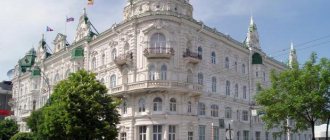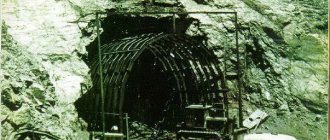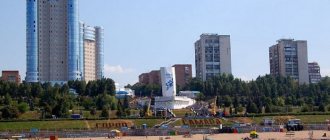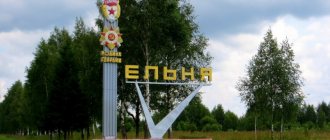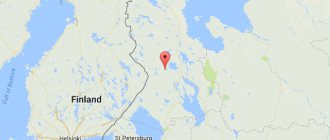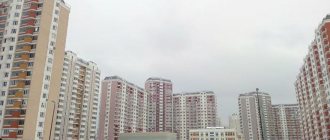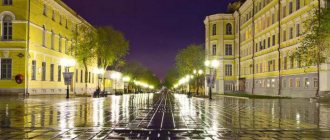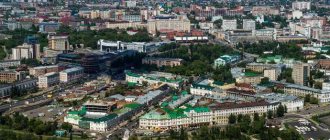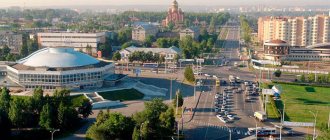The administrative center of the Tambov region is the city of Tambov, which was built on a picturesque hill. This place is washed by two rivers: Studenetsa and Tsna.
Tambov was founded in 1636, although settlements of ancient inhabitants existed here for a very long time.
The city is interesting for its historical sights, museums, cultural events, and festivals that constantly take place here. Therefore, people who move to Tambov for permanent residence will find where to go, what to do and where to relax with friends and children.
Fortress on the Tonbov River
The city arose as a fortified point of the Moscow state in the Wild Field - the undelimited Black Sea and Azov steppes. The sparsely populated territory between the Dniester in the west and the Don in the east, quite suitable for the development of agriculture, cattle breeding and crafts, suffered periodic raids by steppe nomads. To protect the royal lands from enemy invaders, in the first half of the seventeenth century, a fortress was founded, consisting of a fort and the city itself (the Kremlin). The location for the stronghold was chosen on a hill at the confluence of the Tsna and Studenza rivers. The founder of Tambov is considered to be the Shatsky voivode and sovereign steward Roman Boborykin.
The construction of a number of defensive fortresses and fortifications required great efforts from the small local population and a small garrison. However, the spending was not in vain. A reliable barrier was erected to the Tatar raids. One of the modern legends about the founding of the settlement says that the name of the city came precisely from the nomads who, making fruitless attempts to destroy the fortress, shouted “God is there!”
The population of Tambov in those days consisted of a garrison of a thousand soldiers, peasants who were attracted by fertile lands, and feudal lords who came after the farmers. The number of landowners and villagers is unknown, but data on the uprising of 1670 indicates that the peasants who besieged the fortress numbered about three thousand. The uprising was soon suppressed.
At the end of the seventeenth century, the peasant population of Tambov and the area around the fortifications was mainly engaged in felling and logging. Peter I in those days began to quickly build a navy. Tambov wood became its basis.
Population of the Wild Field
The lands where Tambov and many ancient cities are located are located on the territory that was once called the Wild Field. These were uncultivated fertile steppes, suitable for agriculture and practically uninhabited. Raids by nomadic tribes prevented the development of these places, located on the border with Russia. Part of the Wild Field was under the control of the Don, Dnieper and Khoper Cossacks, but this was not enough. Decisive measures were needed on the part of the state to protect the population from the attacks of nomads.
These measures included the construction of defensive structures: fortresses, earthen ramparts, fences and ditches. A guard and village service was organized. In the built fortresses and along the line of defense there was a settlement of service people. Thus, modern cities were founded: Voronezh, Orel, Yelets, Belgorod, Volgograd, Penza, Rostov, Lugansk, Donetsk, Kharkov, Kirovograd, Sumy, Nikolaev, Poltava and many others.
Center of Tambov Viceroyalty
In the eighteenth century, the settlement acquired almost the status of a city: in the first half of the century, the first educational institution was opened there - a soldiers' garrison school. But not many villages near defensive fortresses in Russia at that time could boast of educational centers! In fact, Tambov became a provincial center only after the transformation of provincial government carried out by Catherine II in 1775.
Despite its status as the center of governorship, Tambov remained a “big village”. Wooden houses with thatched roofs, narrow streets without pavements, vegetable gardens and farm yards - all this made up the urban landscape of that time. But the capital’s architects had already begun to develop a development plan at that time. A few more years will pass, and several large buildings, a guest house and public schools will appear in the settlement.
In 1785, Gabriel Derzhavin was appointed ruler of the viceroyalty, whose memory is dear to every native resident of the city. Today the university bears the name of the then mayor. It is not surprising that the population of Tambov treats the poet with great love: he developed shipping along the Tsna and book printing.
Infrastructure Features
Life in Tambov varies in terms of comfort, since not all areas are connected by transport to the center; there are not enough hospitals, shops, supermarkets, parking lots, kindergartens and schools everywhere.
All these points need to be paid attention to before moving and buying an apartment, since this directly affects the standard of living in Tambov.
The housing stock of Tambov is represented by “Khrushchev”, “Brezhnev” and “Stalin” buildings
New residential complexes, microdistricts, neighborhoods, cottage communities and townhouses are also being built.
Old houses are either demolished or renovated, but this does not solve the problem with a large number of dilapidated housing in the city. In the old building, as city residents say on forums, there are often interruptions in heat, lighting, and power supply.
Housing and communal services tariffs
The housing and communal services problem is one of the most serious, according to citizens.
On average, Tambov residents pay 3 thousand rubles for utilities in January. Half of this amount goes to pay for heating. In the warm season, a communal apartment costs 1 thousand rubles. Additionally, you need to pay for house cleaning - 60-100 rubles / month, as well as internet - up to 400 rubles. per month.
In many ways, the cost of housing and communal services depends on the company servicing the neighborhood, as well as on the type of house.
- In modern houses, energy-saving technologies are used during construction to help reduce heat consumption.
- In old houses, there may be huge gaps between the walls, which take a lot of time and money to patch. In such houses and apartments it is cold in winter, and you have to pay a lot for heating.
Public transport
The standard of living is determined by the transport system, the development of roads within the city and in Tambov itself.
The road surface is quickly repaired in various microdistricts of the city, but in the suburbs this is difficult
Due to the increase in traffic on highways and city roads, the Tambov administration began expanding roads. Overground and underground passages are being built to make pedestrian movement safe.
In Tambov there are minibuses, buses, and trolleybuses. There are no tram tracks, as they are not included in the city development plan. Problems with transport are caused by the fact that buses only run until 20–23 pm, which prevents people from getting to remote areas of Tambov.
The situation is gradually improving, as the mayor’s office opens new routes, introduces more buses and trolleybuses on morning and evening routes, and creates “smart stops.”
Educational institutions and hospitals
Parents of children of different ages need to find out more information about kindergartens in Tambov. There are difficulties with such preschool institutions, as elsewhere in the country.
There are many kindergartens in the districts, but their number needs to be increased. Immediately after the birth of a child, parents put the baby in line to take him to the garden near the house.
Universities and schools in Tambov provide modern education. There are city and private secondary educational institutions - classical schools, lyceums, colleges.
Tambov residents and residents of neighboring settlements receive higher education in a wide range of professions in the following institutions:
- A technical and humanities university, they have many students from Africa, Asia, including China, Turkey and Korea;
- technical schools;
- schools;
- branches of other Russian universities.
Tambov State Technical University
Hospitals, like educational institutions, are divided into public and private. Only medical institutions are not open in every microdistrict of Tambov. The cost of medical services and drugs depends on the type of ownership of the hospital and pharmacy.
Before buying an apartment, you need to clarify how to register with the clinic and provide the patient’s personal card. You must also contact the local branch of the Pension Fund to transfer your pension and other social benefits from one city to another.
You don’t have to change your pension certificate, you just need to collect all the papers in order to receive payments from the Pension Fund on time.
Prices in stores
Local supermarkets and hypermarkets have a huge selection of goods, the cost of which is the same as in other regions of the country.
Current prices for products in Tambov are listed below:
- butter, 170 gr. – 76.9 rub;
- log cheese - almost 500 rubles/1 kg;
- sour cream, 180 gr. – about 40 rubles;
- amateur loaf – 26.9 rubles;
- Darnitsky bread – 17.9 rubles;
- suluguni – 441 rub./1 kg;
- Doctor's sausage – 260 RUR/1 kg;
- fresh frozen fish – 149.9 rubles/1 kg;
- baguette – 17 rubles;
- salami in Finnish - about 361 rubles;
- milk, 900 gr. – 54.9 rub;
- wheat flour – 55.9 rubles/2 kg.
- Sugar – 34.9 rubles/1 kg;
- chicken – 116.9 rub./1 kg.
For vegetables and fruits, it is best to go to bazaars and markets operating in different parts of the city. There, local farmers offer their products to residents.
You can buy food at any time of the day in shops and supermarkets that are open around the clock.
The granary of the Russian Empire
With the beginning of the nineteenth century, Tambov changed significantly: the settlement began to look more like a city, and the Kazan and Tenth Fairs made it a center of trade: a wide variety of goods were brought here, and the squares turned into a continuous market for several days. The Tambov province, in addition, became the main breadbasket of the Russian Empire. Some of the grain grown on the lands of the Wild Field even went abroad.
The first official data on the number of city residents dates back to the year before the Patriotic War of 1812. At that time, the population of Tambov was 16,800 people. Most of them either worked in the fields or were engaged in trade. A small part of the townspeople made their living from handicrafts.
In 1812, with the outbreak of war, a people's militia numbering twelve thousand people was formed in the provincial center. Some of the soldiers were from the local population, others were sent from settlements in the area. As the French approached the capital, people from towns near Moscow began to arrive in Tambov. Captured soldiers and officers were also sent here.
Century XX
The beginning of the century coincided with the beginning of the emergence of industrial production in the city. The province was exclusively agricultural, in which a large number of wealthy peasants lived. Tambov, where there were very few representatives of the working class, greeted the February and then the October revolutions of 1917 with great enthusiasm. This was due to the distribution of land, according to the “Decree on Land” proclaimed by the Bolsheviks.
The peasants began to arbitrarily seize the land of landowners and large landowners, but ran into resistance from the authorities. Mass conscription into the Red Army began as the Civil War was raging. This caused discontent. The region became a hotbed of strong uprisings against Soviet power, the most famous of which was the Antonovsky rebellion. They were all brutally suppressed.
The Soviet years were marked by the opening of new schools, which were formed in connection with the elimination of general illiteracy. In the 60s, the industrialization of the city began. New enterprises were built and put into operation. A huge amount of housing has been built. Clinics, kindergartens, stadiums, music schools and much more were opened. Everything that Tambov has today was built during the Soviet years.
Statistics 1840
By the end of the first half of the nineteenth century, there were forty-five streets in Tambov, including two embankments of the Studenets and Tsna rivers, as well as eight alleys. There were more than two thousand private houses, but only sixty-nine of them were made of stone. Visitors could use the services of three hotels. The population of Tambov rested in seven taverns, five taverns, twenty drinking houses, and eight damask shops. There were seven clothing and dry goods stores, and twenty-five inns. Eight wells were installed to ensure water supply.
The population of Tambov was the same 16,800 people. Young people could study in gymnasiums and colleges. The Alexandrinsky Institute of Noble Maidens and a cadet corps were built - all this made the city of Tambov quite large and wealthy at that time. Social protection of the population was represented exclusively by hospitals, where locals could get doctor's advice. The Ascension Convent and the Kazan Monastery were also erected in the city.
All this data is provided by Staff Captain Kuzmin. In addition, statistical information was contained in the Military Statistical Review of the Russian Empire, in the section concerning the Tambov province.
Tambov in the 21st century
Today Tambov is a developed industrial center. Although the population of Tambov in 2016 decreased by 481 people compared to the previous year. The city has factories producing machinery, equipment (electrical, optical, electronic), and vehicles. Chemical production is well developed. The largest enterprises in Tambov are: TambovPolymerMash, Oktyabr, Komsomolets, Revtrud, Pigment, Efir and others.
Komsomolets produces various types of steel - corrosion-resistant, heat-exchange, carbon and capacitive. In addition to steel, the production of bimetal and aluminum, as well as column equipment made of copper, has been established. The equipment produced is used by factories in the chemical and oil and gas industries. "Revtrud" is famous for its construction materials and special electronic warfare and communications equipment. sells products under the Krata brand in all regions of Russia and in foreign countries. During the years of the existence of the USSR, Tambov factories produced more products, there were more of them, and they worked at full capacity. Today, the buildings of closed industrial enterprises have been converted into retail supermarkets. Among them is the well-known “Auchan”.
According to statistical calculations, there is a huge amount of unrecycled garbage in the city. Until the last decade of the 20th century, a waste processing plant operated in Tambov. After temporarily ceasing his activities in the mid-90s, he never returned to work. This did not stop experts from classifying Tambov as one of the most prosperous and environmentally friendly cities in Russia. The population in 2016 has increased due to volunteers who are ready to support this status.
Industrial growth
Since the beginning of the twentieth century, Tambov has experienced active industrial growth. There is not only quantitative, but also qualitative growth of enterprises. The city ranked first in the empire in shag production. At the same time, joint stock companies and industrial companies began to be created.
In 1919, with the establishment of Soviet power, which took place in Tambov with great intensity, it opened, whose task was to repair and manufacture military equipment. The enterprise operated on the basis of former artillery workshops. Thus, the population of Tambov and the Tambov region was provided with jobs with good salaries.
Nowadays
No other city has as many positive reviews written about it as Tambov and its residents. The overwhelming majority of reviews are from visitors. The city is small, spotlessly clean and green. It seems that the forest begins right in the city, as there are many parks and squares. There are many sports facilities, modern hotels, shopping supermarkets, there is a central market in Tambov, where the TSUM shopping center is located. And yet, the city is small and a little provincial.
Fate saved the city from the destructive wars that swept across Russia, from too irresponsible leaders trying to reshape not only the city, but also the country for the sake of personal interests. The destruction affected only Orthodox churches, but those that remained, restored and rebuilt, now serve as decoration for the city and create its uniqueness. Here you can see merchant Tambov, buildings and monuments of the Soviet era, and modern buildings.
Fate saved it from being renamed the city of Tukhachevsk; monuments were not demolished here. Tambov has always remained Tambov. Many people want to know where Zarechye is located in Tambov. On the territory of the Tambov region there are three settlements with this name: in the Tambov, Sosnovsky and Pichaevsky districts.
Peasant revolts
After the revolutionary events in Petrograd, the population of the center of the province expected a fair solution to the land issue. However, the lack of reforms became the reason for the unauthorized seizure of landowners' lands by peasants. In the summer of 1917, more than three hundred peasant encroachments on the property and land holdings of local landowners were recorded.
Major revolts on Tambov soil continued from 1917 to 1921. The anti-Soviet movement died out when the government adopted a decree “On the temporary distribution of land,” which was what the peasants demanded from the very beginning.
Tambov under Soviet rule
The Soviet government made every effort to develop industry and culture in Tambov and improve the city. Almost immediately after the end of the uprisings, the theater began operating under the leadership of Stanislavsky’s student. In 1928, the work of the Tambov Carriage Plant was launched, in 1932 Avtotractorodetal was founded, and in 1933 it was opened. Almost all production facilities of the enterprises were based on the former workshops of local entrepreneurs.
Work was actively carried out to eliminate illiteracy. A pedagogical institute opened in 1930, a Puppet Theater appeared in the city in 1934, and a philharmonic society in 1937. At the same time, the settlement became the largest book depository in the Tambov region.
In 1936, the question was raised about renaming the city to Tukhachevsk, in honor of M. N. Tukhachevsky, a Soviet military leader. After being trumped up on charges of organizing a conspiracy to violently seize power, Tukhachevsky was repressed. The question of renaming was dropped.
The city's prosperity peaked in the seventies and eighties of the twentieth century. Over the course of fifteen years, more than two dozen social facilities were built, and residential areas of typical Soviet construction were actively built. What population in Tambov was recorded by statisticians in the “best times”? The number of citizens as of 1987 was 305 thousand people.
The Internet resource “Tambov Today”, together with radio Retro-FM Tambov and the portal about the Tambov region smartregion68.ru continues the series of materials “Discovering the Tambov Region”.
City coat of arms
Date of adoption: 07/30/2008 Number in the Heraldic Register of the Russian Federation: 4233 In an azure field with a green tip on top of everything there is a golden hive, accompanied by three golden bees at the head, positioned in a fan shape. Rationale for symbolism: The coat of arms of the city of Tambov is an ancient symbol of the city, first approved by the Empress Anna Ioannovna in 1730, confirmed by Empress Catherine II in 1781 and restored to use by the decision of the Tambov City Duma in 1996. The hive and bees remind of the wealth of the city of Tambov, the hard work, harmony and good neighborliness of its inhabitants. The coat of arms of the city of Tambov is one of the old coats of arms in Russia. The description, Supremely approved on August 16, 1781, says: “On an azure field there is a beehive and above it there are three golden bees, the earth is green. (Old coat of arms)". For the first time, the coat of arms was approved as an emblem for the banners of the Tambov dragoon regiments, becoming part of the banner armorial in 1729-30. The basis for the coat of arms of Tambov was the emblem from the book “Symbols and Emblems”, popular at the beginning of the 18th century. The hive with bees and the motto that explains it, “Everyone is closed,” very accurately reflected the history of the appearance and development of the city. Tambov was founded by decree of Mikhail Romanov in 1636. The captain Roman Bobarykin and his servants founded a fortress on the left bank of the Tsna River near the crossing, on the ancient Ordabazarnaya road connecting Moscow with the Lower Volga region. The new fortress connected two large defensive lines on the southern borders of the Russian state. Despite the fact that the walls of Tambov were repeatedly besieged by Tatar and Nogai hordes, it was never captured. For over 100 years, the Tambov fortress fulfilled its military purpose, reliably protecting the entire district. But the city glorified itself not only for its military prowess. The hive and bees reflected one of the thriving local industries of that time: the Tambov land in those days was famous for its beekeeping lands. The qualities of local honey were widely known throughout Russia. Meadow herbs and linden forests became the key to the special taste and healing powers of Tambov honey, which was always highly valued. The choice of a beehive and bees as a coat of arms became an allegory of economic development: The bee is a traditional symbol of hard work, frugality and order, diligence, fertility and abundance. Since the mid-18th century, Tambov has been a trade and economic center of a large agricultural region. And the construction of the Ryazan-Ural Railway in 1869 gave a good impetus to the development of the city, the revival of trade and the emergence of metalworking enterprises. The development of the city has never stopped. By the end of the 20th century, Tambov had become a major industrial center with developed branches of chemical engineering and electrical production. The labor feat of Tambov residents during the Great Patriotic War was marked with an order: on April 25, 1986, by Decree of the Presidium of the Supreme Soviet of the USSR, the city of Tambov was awarded the Order of the Red Banner of Labor. Author group: reconstruction of the coat of arms: administration of the city of Tambov; consultation: Konstantin Mochenov (Khimki); artist and computer design: Oksana Afanaeva (Moscow); rationale for symbolism: Kirill Perekhodenko (Konakovo). Approved by the decision of the Tambov City Duma (#711) dated July 30, 2008.
City flag
Date of acceptance: 07/30/2008
Number in the Heraldic Register of the Russian Federation: 4234
A rectangular panel with a width to length ratio of 2:3, consisting of two horizontal stripes: blue (at the top, 2/3 of the width of the panel) and green, in the center of which is a yellow beehive (the overall height of which is 1/4 of the length of the panel) , above which there are three yellow bees, arranged in a fan shape.
Rationale for symbolism: The flag was designed based on the city’s coat of arms - one of the old coats of arms in Russia. The description of the coat of arms, Supremely approved on August 16, 1781, says: “On the azure floor? a beehive and above it three golden bees, the earth is green. (Old coat of arms)". For the first time, the coat of arms was approved as an emblem for the banners of the Tambov dragoon regiments, becoming part of the banner armorial in 1729-30. The basis for the coat of arms of Tambov was the emblem from the book “Symbols and Emblems”, popular at the beginning of the 18th century. The hive with bees and the motto that explains it, “Everyone is closed,” very accurately reflected the history of the appearance and development of the city. Tambov was founded by decree of Mikhail Romanov in 1636. The captain Roman Bobarykin and his servants founded a fortress on the left bank of the Tsna River near the crossing, on the ancient Ordabazarnaya road connecting Moscow with the Lower Volga region. The new fortress connected two large defensive lines on the southern borders of the Russian state. Despite the fact that the walls of Tambov were repeatedly besieged by Tatar and Nogai hordes, it was never captured. For over 100 years, the Tambov fortress fulfilled its military purpose, reliably protecting the entire district. But the city glorified itself not only for its military prowess. The hive and bees reflected one of the thriving local industries of that time: the Tambov land in those days was famous for its beekeeping lands. The qualities of local honey were widely known throughout Russia. Meadow herbs and linden forests became the key to the special taste and healing powers of Tambov honey, which was always highly valued. The choice of a beehive and bees as a coat of arms became an allegory of economic development: The bee is a traditional symbol of hard work, frugality and order, diligence, fertility and abundance. Since the mid-18th century, Tambov has been a trade and economic center of a large agricultural region. And the construction of the Ryazan-Ural Railway in 1869 gave a good impetus to the development of the city, the revival of trade and the emergence of metalworking enterprises. The development of the city has never stopped. By the end of the 20th century, Tambov had become a major industrial center with developed branches of chemical engineering and electrical production. The labor feat of Tambov residents during the Great Patriotic War was marked with an order: on April 25, 1986, by Decree of the Presidium of the Supreme Soviet of the USSR, the city of Tambov was awarded the Order of the Red Banner of Labor. The ribbon of the order can decorate the city flag on special occasions
Author group: idea of the flag: administration of the city of Tambov; consultation: Konstantin Mochenov (Khimki); artist and computer design: Oksana Afanaeva (Moscow); rationale for symbolism: Kirill Perekhodenko (Konakovo).
Approved by the decision of the Tambov City Duma (#712) dated July 30, 2008.
City `s history
Several centuries ago, at the picturesque confluence of the two rivers Tsna and Studenets, by decree of Tsar M.F. Romanov (the first tsar of the Romanov dynasty), a fortress city was founded by the steward R. Bobarykin and his service people. This defensive fortification was supposed to protect the southern borders of Rus' from the encroachments of foreign invaders: Tatars and Nogais. The decree on the construction of the fortress was signed by the hand of Tsar Mikhail Fedorovich. The founder and first governor was Roman Boborykin.
The fortress received the original name “Tonbov”, consonant with the name of the river and the small Mordovian village on the coast. The new fortification borrowed its name from the local dialect and transformed into Tambov (otherwise known as the “pool”). This was in 1636.
However, the city was still considered a defensive fortification and this significantly hampered its economic development. In 38 of the 18th century, the city was again “re-armed”. The hasty strengthening of Tambov was associated with the beginning of the Russian-Turkish war. But Tambov was no longer intended to play a defensive role.
In the 17th and 18th centuries, Tambov was considered part of other provinces. And only in 1779, during the reign of Catherine II, the city became the head of the Tambov governorship. R.I. Vorontsov was appointed governor. After 2 years, Tambov even received its own coat of arms. To this day, the main symbol of the city proudly displays a beehive and three toiling bees above it. The choice of this hive was marked by the fact that Tambov residents have been collecting wild honey since the founding of the city. Outwardly, at that time, Tambov looked more like a village than a city: unpaved, crooked streets, low wooden houses with thatched roofs.
In 1796, Tambov became the center of the vast Tambov province.
The appearance of the city changed only with the arrival of a new governor, the famous poet G. Derzhavin. He did a lot for the development of Tambov. New wooden buildings began to decorate the former military fortress, streets began to be paved, and dam construction began. Under Derzhavin, the city began to change its cultural appearance: the first school of 4 classes and a club were opened. In Tambov, the first of the quiet provincial towns, there appeared its own printing house, publishing a local newspaper. The Russian poet, in the role of manager, dealt with the problem of shipping. Thanks to his efforts, navigation was established along the main city river Tsna. This innovation made it possible to deliver stones and timber needed for construction to the city. But Derzhavin’s resignation again stopped the rapid urban development for many years.
The city stirred up after stagnation only in 1838 with the advent of A. Kornilov as governor. During the 5 years of his leadership, Kornilov raised the educational level to a new level. Under him, an institute for training girls was opened, and a school training clerical workers “moved” from Voronezh.
The beginning of the 19th century found Tambov a small provincial town still living by trade in livestock, wool and grain.
The glorious year 1812 was marked in the history of the city with a great upsurge of patriotism and unity. Tambov militias, who glorified their land in the battles on the Berezina River, left the walls of the unfinished cathedral to fight for the Fatherland.
In the middle of the century, the city expanded: new stone houses began to appear, the administrative staff increased, and new city nobility flocked to Tambov.
After the fall of serfdom, Tambov turned into a typical noble, bureaucratic and merchant city. A big impetus to its development was given by the construction of the Ryazan-Ural railway through Tambov in 1869. This led to a revival of trade and the emergence of metalworking enterprises in the city. In 1885, a water supply system was laid in Tambov. By the end of the century, squares and parks appeared in the city, there was a theater, a public library, a hippodrome, and more and more hotels, restaurants, and entertainment venues were opened. Well-known Tambov philanthropists E. D. Naryshkin, A. M. Nosov, V. M. Anosov, M. S. Ashurkov donated churches, schools, hospitals, and houses of contempt built at their expense to the city.
Car repair shops (1899) became a large enterprise in the metalworking industry in Tambov; in addition to them, small factories of Petter and Makhov operated. By 1913, 2.4 thousand workers were employed at industrial enterprises in Tambov.
The years of the first Russian revolution open a new political page in the history of Tambov. Until this time, Tambov did not stand out among Russian cities with any noticeable manifestations in political life. The urban strata were passive about the propaganda work of the populist revolutionaries in the second half of the 19th century, who tried to find helpers or at least sympathizers here.
The situation changed dramatically in the early years of the 20th century. Among the political parties operating in Tambov, the positions of the Socialist Revolutionaries and anarchists were strong. The role of the Bolshevik Party in the events of 1905-1907. in Tambov it was much more modest. Along with the proletariat, student youth acted as an active political force in Tambov. Among the latter, future revolutionaries, full of determination and dedication, showed themselves. In Tambov, the ideas of such representatives of future revolutionary changes as M. A. Spiridonova, V. N. Podbelsky, A. S. Antonov, M. D. Chichkanov were born and strengthened. Soon they found themselves on opposite sides of the barricades, but their participation in the historical events that took place in Tambov was the first step in their subsequent life, full of hardships, contradictions and deprivations.
The manifestation of socio-political activity in Tambov in the period from 1908 to 1917 was insignificant. Soviet power in the Tambov province was established in March 1918, i.e. later than in the vast majority of other Russian cities. A more striking mark on the history of Tambov at that time was left by the events dedicated to the solemn glorification of St. Pitirim, which took place on Cathedral Square in July 1914 and attracted several tens of thousands of people. It should also be noted the patriotic upsurge of the city’s public associated with the outbreak of the First World War. However, in subsequent years, the protracted war led to dissatisfaction with the autocratic government and the aggravation of social contradictions, which was reflected in some of the events that took place in Tambov in 1916-1917.
In the summer and autumn of 1917, the most active political force in Tambov were the soldiers of the infantry regiments stationed in the city. The demands they put forward mainly concerned an end to the war. With the direct participation of soldiers from the city garrison, riots occurred in Tambov in September 1917, which led to a pogrom of the city's trading establishments.
In the summer of 1918, dissatisfaction with the new government began in Tambov. Their first mass manifestation was an armed rebellion that occurred on June 17-18, 1918. The striking force of the rebels was numerous peasant youth, mobilized for service in the Red Army. With the help of representatives of the Socialist Revolutionary Party, the peasant boys, dissatisfied with the mobilization, managed to obtain weapons from local military units. Students of the Tambov gymnasium and other segments of the city's population joined the rebels. In those days, Soviet power in Tambov was liquidated. Many Tambov communists were arrested and imprisoned. The power in the city was taken over by the old city council. Literally the next day, the rural youth who took part in the rebellion dispersed to the villages. Representatives of the Soviet government who remained free took advantage of this and quickly organized the suppression of the rebellion with the support of units of the Red Army.
In August 1919, Tambov was unexpectedly captured by the White Cossack corps of General Mamontov. In two days, while Tambov was in the hands of the White Cossacks, all Soviet and party institutions, all shops, warehouses and enterprises were destroyed. Soon Mamontov's corps left Tambov with impunity, continuing a successful raid in the direction of Kozlov. It should be noted that this was the only case in the history of Tambov when the city was captured by the enemy.
In 1920-1921, the headquarters for suppressing the peasant uprising, known in history as the Antonov rebellion, was located in Tambov. Having carried out many successful operations in various districts of the province, the regiments of the peasant armies did not capture the provincial center, but the dungeons of the provincial Cheka turned out to be the last place in life for many of them.
In 1918, by decision of the City Executive Committee, Tambov lost the names of many of its streets. Instead, new ones appeared, “developed by the city executive committee at its discretion in accordance with the spirit of the times.”
In the same year, actions began to nationalize private property in the city, attract wealthy urban residents to forced labor, and confiscate their excess living space (the “densification” campaign).
One of the first transformations of the new government concerned the education system. In 1918, all gymnasiums, real and diocesan schools were liquidated in Tambov, at the same time labor schools and a university were opened, which existed until 1921.
In the post-revolutionary years, rapid industrial development began in Tambov. First of all, these were enterprises for the production of cloth and yarn.
In the 20-30s, the composition of the urban population changed noticeably. In fact, the city lost most of the pre-revolutionary classes, but was replenished with people from the village, among whom were many members of the families of dispossessed peasants.
For a long time (since 1914) there was practically no construction in Tambov. With the exception of isolated objects (for example, the Banner of Labor club) built in those years, the townspeople used what had been built earlier.
In 1928, Tambov ceased to be a provincial center, but became part of the Central Black Earth Region, and since 1934 - part of the Voronezh Region. The city acquired its current status as a regional center in 1937, when the Tambov region was formed.
At the end of the 30s, construction of residential buildings, industrial and cultural facilities resumed in Tambov. At the same time, new educational institutions appeared in the city (schools, technical schools, pedagogical institutes, military schools), the first industrial facilities were created and gained strength (Komsomolets, ATD).
During the harsh years of the Great Patriotic War, the city of Tambov and its residents fully shared all the trials that befell the country. Tambov became a haven for many hundreds of refugees. Twice it actually became a front-line city, when in November-December 1941 Wehrmacht units were between Yelets and Lipetsk, and in the second half of 1942, when the front line passed through Voronezh. The proximity of the front did not allow industrial enterprises from the western regions of the country to be evacuated to Tambov, but for the same reason Tambov was filled with evacuation hospitals. Seriously wounded soldiers were most often brought here in large numbers. Many of them died from their wounds and were buried in Tambov, which explains the presence of large military graves at the Vozdvizhenskoye cemetery in the city.
Due to the proximity of the front, Tambov found itself at the center of formations of large military units. In the Suburban Forest near Tambov there was the headquarters of the 2nd Army being created on the territory of the Tambov region.
The construction of defensive lines, bombing by enemy aircraft, meager food rations, donating blood and selfless work in the name of victory - all this fell on the shoulders of Tambov residents in those unforgettable years.
In the post-war period, Tambov, which did not experience severe military destruction, remained aloof for several years from the colossal construction that took place in cities destroyed by the war. Housing construction in the second half of the 40s in Tambov was carried out on an insignificant scale. Much more attention was then paid to the development of the city's industrial base. Plants such as boiler-mechanical (now Tambovmash JSC), ATI (now ARTI Plant JSC), AKZ (now Pigment JSC), and Tambov CHPP were built.
In the 40s of the last century, the Industrial District of Tambov became the independent city of Kotovsky.
Throughout the 50s, a sharp increase in private housing construction became a characteristic phenomenon for Tambov. The areas of housing plots and the size of buildings, strictly controlled by local authorities, formed new neighborhoods on the city plan. In those years, Tambov went far beyond its former borders in the western and northern directions.
In the 1960s, private residential construction was supplemented by the construction of multi-storey residential buildings, which accompanied the intensive industrial development of the city. Blocks of 4-5-story buildings stretch in a long strip in a northwestern direction along Michurinskaya Street, where a high-rise television repeater was installed in 1958. In 1969, the first nine-story buildings appeared in the southern part of Tambov. Since 1961, gasification of residential and industrial facilities began in Tambov, thanks to the construction of a main line from the Saratov gas field.
In 1965, the city was divided into 3 districts (which remain today): Oktyabrsky, Leninsky and Sovetsky.
The well-developed construction industry of the city, represented by such enterprises as the Tambovkhimpromstroy, Tambovstroy, Tambov DSK trusts, continued to form a new image of the city in the 70s. During this period, the renovation of the central quarters of Tambov began. In the early 80s, one of the main streets of the city, Internatsionalnaya, changed beyond recognition, and Kommunalnaya Street was reconstructed. On the once swampy meadow expanses of the right bank of the river. Tsna arose a green array of garden plots.
In the 70-80s, new modern cultural facilities appeared in Tambov: the Yubileiny cultural center, the Yunost and Aurora cinemas, the Antey and Kristall sports palaces. In the city, old city parks and squares were updated and reconstructed. New residential microdistricts were built in Tambov - the fourteenth and sixteenth blocks, the residential groups “Molodezhny”, “Polimemash”, “TIHM” and others.
By the beginning of the 90s, there were 3 universities and 3 higher military schools, several research and design organizations in Tambov.
Tambov today is no longer a hub or strategically significant city for the Russian Federation, largely due to its geographical location. In the age of fast transport and instant decisions, it seemed to be on the border between metropolitan satellite cities and an independent, but strong outback. Almost 450 kilometers separate it from Moscow, and that is why the road race to Tambov is so difficult and the airport, which receives one plane a day, is so unimportant.
However, not a single guest or passer-by who happens to be here can deny Tambov’s appeal. Narrow streets, numerous squares, parks and fountains - all these attributes of a wealthy “outback” literally fascinate a resident of a metropolis. And historical monuments, of which there are plenty in Tambov, are not so important - the style and pace of life itself is important and attractive
Current position of the city
Now Tambov is a large populated area. It is distinguished by its favorable geographical location, relative proximity to the capital, and large highways connecting the city with the south and center of Russia. In the last decade, the amount of garbage here has increased, but this fact has little effect on the environmental situation: Tambov remains one of the fairly clean and green cities in Russia.
The Tambov Employment Center provides citizens with a sufficient number of vacancies due to the need to find workers for the construction of new microdistricts, supermarkets and other facilities. Trade employees are also required.
The population of Tambov is provided with everything necessary for a comfortable life, but there are also certain problems. The latter include insufficient water and heat supply, which is especially important for residents of the Oktyabrsky district, inflated tariffs for housing and communal services, and inappropriate maintenance of stairwells and basements. In terms of crime, the situation is good.
Today's demographic situation
What is the population of the city of Tambov now? At the moment, the demographic picture is unfavorable. Almost 285 thousand people live in the city. Natural population decline and migration of city residents to other regions are the reason that Tambov ranks third in terms of the highest rates of decline. The population is declining, and the process is stable and has practically not stopped since the nineties.
Of course, the Tambov Department of Social Protection of the Population is striving in every possible way to stimulate a change in the situation for the better. But the birth rate exceeded the death rate, which caused an increase in the population, not for long: since 2010, the number of residents has gradually increased, but in 2016 a negative figure was again recorded. Then the population of Tambov decreased by about four hundred thousand people. Now, as already mentioned, the number of citizens is almost 285 thousand.
What is the population of the city of Tambov? By ethnic composition, the majority of townspeople are Russians (almost 95%). The following ethnic groups follow:
- Ukrainians (0.67%);
- Armenians (042%);
- gypsies (0.38%);
- Tatars (0.21%)
- Azerbaijanis (0.18%);
- Yezidis - an ethnic group professing Yezidism (0.17%);
- Belarusians (0.14%) and others.
The majority of Tambov residents (about eighty percent of the population) profess Orthodoxy, there are also Old Believers, Catholics, Baptists and representatives of other religious communities and beliefs.
Population of Tambov
Over the past decades, a difficult demographic situation has developed in Tambov. In the first ten years of the 21st century, the city experienced a steady decline in the number of residents and a decrease in the birth rate. Today, experts predict an improvement in the situation in the demographic sense, but there are no more city dwellers and the population is still declining.
This state of affairs is typical for most Russian cities. Tambov is no exception. Population numbers in 2016 again showed a decrease in growth. Sociologists predict Russia will fall into a demographic hole. The natural decline in population growth is unlikely to stop in the next decade. In the city, there are about 60 percent of able-bodied citizens, 15 percent are young people under this age; 24 percent are people of retirement age. In recent years, Tambov authorities have been taking measures to increase the birth rate: supporting families with three or more children, increasing the value of family, and so on. The developed plan allows us to hope for an increase in the birth rate until 2025. The population of Tambov in 2016 is almost three hundred people. This is the result of a small number of favorable years when the population increased. It lasted from 2010 to 2015.
In addition to the birth rate, migration to Tambov allows the number of city residents to increase. Operating universities (there are two of them in the city: Humanitarian named after G.R. Derzhavin and Technical) attract citizens from other countries to Tambov. The largest number of foreign students are from Turkey, Korea and African countries. The population of Tambov in 2016 did not receive less population growth compared to 2015 due to stricter rules for attracting migrants to work in the Russian Federation.
Economic situation
The Tambov Employment Center reports that the average salary in the city is twenty-nine thousand rubles. But in fact, you can only count on ten to twelve thousand. This is the salary that applicants are offered at most jobs. In addition, it is believed that it is almost impossible to get a good position without making contacts. This assumption, unfortunately, is close to the truth.
The labor market is determined by a large number of shopping centers. The Employment Center (Tambov) currently offers vacancies mainly in the field of trade and services. Conditions at such enterprises are not the best:
- irregular working hours;
- work on holidays and weekends;
- no extra pay for night shifts.
There are vacancies at industrial enterprises. For example, a dairy plant provides jobs to a large number of city residents. Hard work in a distribution center pays quite well.
The Tambov Employment Center from time to time offers vacancies from factories. This kind of work is not popular in the city and does not require high qualifications, but allows you to earn a decent salary. The city has a confectionery factory, a bread equipment manufacturer, Pigment, a chemical enterprise, and Revtrud, a supplier of communications equipment, consumer goods, and construction materials.
Vacancies at the employment center (Tambov) are rarely filled with popular positions of managers or administrators, but such advertisements can be found in local newspapers. True, under the beautiful cover of office work, vacancies for sales representatives are often hidden.
The city's attractions
The most recognizable symbol of the city is the Tambov wolf, whose image is depicted on souvenirs. There is no artistic representation of the wolf in the city, only a small wooden sculpture stands at the entrance.
In the center, on Lenin Square, there is a monument to Vladimir Ilyich. Nearby is a monument to Zoya Kosmodemyanskaya, the first woman to be awarded the title of Hero of the Soviet Union, a native of the Tambov region. And the calling card of Tambov is the embankment. The Tambov Peasant Monument can also be called a colorful attraction, and seekers of new sensations should visit the Museum of Sin, where unusual exhibits are collected - fragments of the human body and internal organs.

